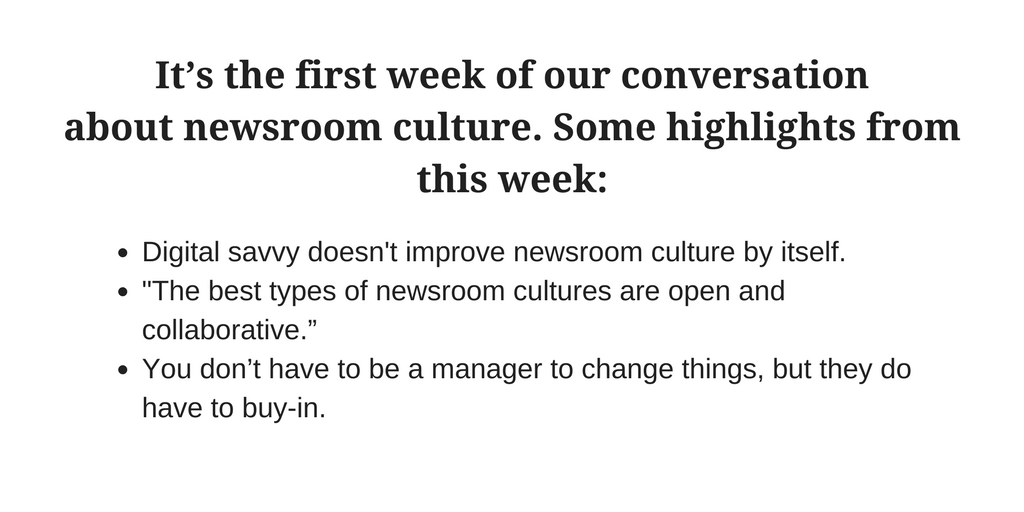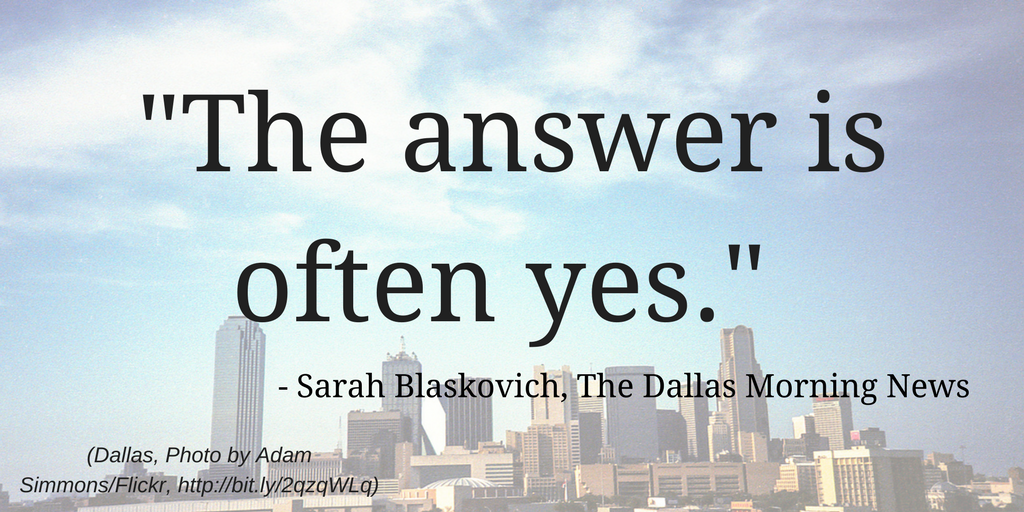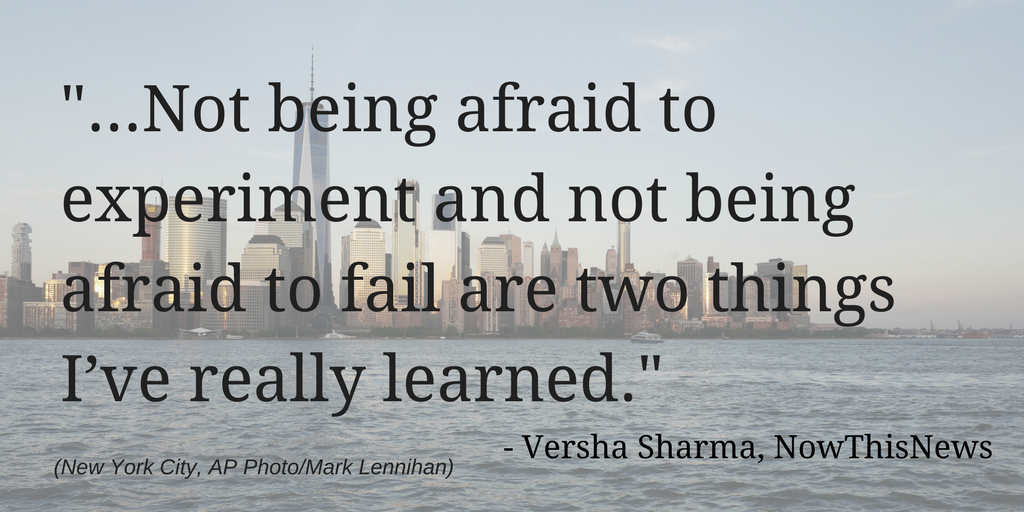This piece originally appeared in Local Edition, our newsletter following the digital transformation of local news. Want to be part of the conversation? You can sign up here.

On a job interview years ago, an intern took me on a tour of the building. While we walked, she told me about some of the history.
Eventually, she asked if I had any questions.
One, I told her. Is this a nice place to work?
Nice? I remember her saying. That’s a stupid question.
I stopped and turned to face her.
Have you ever worked in another newsroom? I asked.
No, she said.
OK, I told her. It’s not a stupid question. Newsrooms can be defensive, cutthroat, cryptic places. I want to know if this is one of them.
...This is a nice place to work, she finally told me.
In the three newsrooms I’ve worked in, including at Poynter, there have been great things about the culture and things I’d rather forget. But what makes a work culture? How do they change? Who can change them?
I’ve written about journalism culture (mostly the fun stuff) for years, and when we get to these kinds of questions, there’s always someone ready to invoke our great, grizzled forefathers and how they didn’t give two shakes about culture.
I disagree. For generations, we’ve told the world what our culture is on the front of our buildings, at the top of our mastheads and through the things we fight for.
The best, most important things about being a journalist are worth talking about and preserving. The crappy things, the ones we can change and leave behind, are, too.
And all of this matters as newsrooms look to change how they work to build audiences and stay in business.
So, ugh, culture. I know. But we’re going to talk about it for the next several weeks.
To start us off, I talked with two journalists who work in totally different places but have a lot in common. Sarah Blaskovich is a lifestyles editor and restaurant and bar writer at The Dallas Morning News. Versha Sharma is a managing editor and senior correspondent at NowThisNews in New York.
Our conversation has been edited for length and clarity.

When we talk about culture, what are we actually talking about?
Sarah: To me, newsroom culture is about people. It’s about how people treat each other and the situation around how people want to do work, hopefully good work, if the newsroom culture is one where they feel empowered and important and heard.
Versha: I would completely agree with that. When we talk about newsroom culture, we’re talking about the ways that people work together and can support each other. We encourage independent work and people taking initiative on their own, but they don’t have to do that in a vacuum. The best types of newsroom cultures are open and collaborative.
Versha, we talked a little on Facebook, and you had really good things to say about the culture at NowThis. What are the things specifically that make that a good culture for you?
Versha: Going back to the idea of just being supportive and collaborative. I just feel like my ideas and opinions are valued. People seem to respect them. People ask for them. But that’s not just the case for me, it’s the case for everyone in the newsroom, from the most senior producer to the most junior.
I think that leads to a lot of open discussions and is really rewarding.
Sarah, I’ve heard that what’s happening now in Dallas is they’re taking the culture at GuideLive (the newspaper’s entertainment vertical) and bringing it into the larger newsroom. What’s happening on that team that’s working so well?
Sarah: The backstory is that GuideLive broke off, and I should say I was not in charge when this happened. I was just a lucky member of the team. But we broke off and pretended like we were a startup.
What that created is this mentality that we all have to work hard because we don’t have dozens or hundreds of people that can help. But what it also meant was (that) everybody was empowered to do jobs that they may have thought of as somebody else’s.
So we took that mentality and now we’re back part of the newsroom, and I think that’s really important, we’re the entertainment arm of The Dallas Morning News.
Some of the things that we took away are that every reporter has to be nimble and quickly responsive, whether that’s to a story or new technology or using Slack, which we hadn’t always done but we do now. So it’s a lot about attitude.
The answer is often yes.
That’s one of the things I love most about the GuideLive group. When we’re asked to do something, realistically, if the answer has to be no, it might be. But most of the time, the answer is yes, and I’ll figure it out.
There are lots of tasks that we’re given that we don’t know how to do. But we know how to figure it out and we have the attitude to do so.
The larger newsroom is trying to adopt that approach now, right? How is it going?
Sarah: Having been here for five years and a leader for a year and a half, I can say the newsroom culture is hugely different than it was when I started. A lot of it has to do with changes in communication.
I think also, there’s a friendliness in the newsroom that I hadn’t seen before among colleagues. People seem to care a little bit more about everybody else’s families. We’re a big family-oriented team. I have a newborn, so juggle family and work. We hopefully all do it well, it’s important to us.
There’s a beautiful cynicism across the newsroom here, and I hope that always continues, but when you’re talking about your colleagues, there’s a lot more collaboration and there’s a lot more understanding about what those humans might be going through and how you can help them out if they need your help.
Versha, you have worked in digital-first organizations for most of your career. Have you always found the culture in those places to be like what you have now?
Versha: No, I’ve definitely had different experiences. I’ve definitely worked at startups where the culture was actually pretty toxic. So I can be appreciative of what the culture is at NowThis.
I think one of the reasons our culture works is we all have a shared understanding and vision of what the goal is, and that is making great content and video for a mobile-first audience. Not only are we digital-first, we’re now mobile-first.
That’s something that has been embedded in NowThis from day one. When you walk in the door, what we’re talking about is, “what apps are you using?” “How do you consume your news on mobile?” Always understanding that that’s what our goal is and making sure every producer has that top of mind, from pitch to finished product, it’s been a recipe for success for us.
What do you think journalists, as a profession, get wrong about culture? We can be fiercely competitive, we can be like Sarah said, beautifully cynical. Are there things that are profession-wide, not digital vs. legacy, that you think we get wrong about culture?
Sarah: One thing that I have seen both in my company and in other companies is a territorialism over a beat that results in work that could have been better.
I write about restaurants and bars, and if there’s stuff happening at restaurants and bars, of course I want to know about it, and I want to think I’m the person who knows the most about it. I think most good beat reporters think that way.
However, sometimes, I go on vacation. And sometimes, I’m in a meeting. And sometimes, news breaks and somebody else needs to handle it. And I think we need to be a little more OK with a very smart person picking up that ball and running with it.
And the reason is time. We get beat by other people, and the worst thing is to have nothing on a topic that really you’re supposed to be the best voice for.
Something we do on GuideLive that I really like is we edit each other’s work. That offers this opportunity for reporters to feel like they know how to work with their colleagues. It also means if someone’s edited one of my restaurant stories, and then they need to write a restaurant story quickly, they know a little bit about it.
I think empowering journalists to do great work to help your colleagues may lessen a little bit of that competitiveness. And in the end, all we really want to do is write great stories for people.
Versha: I agree with that. I think it also extends to trust among colleagues. It’s great to be cynical and skeptical, but you don’t always have to apply that to how you interact with your colleagues.
What that tendency leads to is less communication.
The more voices, especially the more diversity of voices, you bring to the table, the better. That’s where journalists can sometimes get hampered in their ability to want to play in their own circles.
Are there things about legacy culture that we should hold on to?
Sarah: That’s a great question. Yeah. I wouldn’t say that all of the old newsroom doesn’t work. At The Dallas Morning News, I can see a good amount of trust in the people who have done this for a long time.
I find myself, as a 31-year-old young leader, asking a lot of questions of those people. We always did revere our best journalists, and I think we still do. We should continue that.
I’m also thinking about transparency, this insatiable curiosity…
Sarah: Yeah, the basic tenets of the journalism – getting the facts right, being first but also being accurate and not letting one or the other go, all that stuff still applies and it’s not just in digital startups, it’s everywhere that that kind of journalism needs to live on.
And I think it does.
It can be easy to fetishize digital newsrooms, but Versha, are there things about that culture we should all learn and try to keep?
Versha: Absolutely. I think not being afraid to experiment and not being afraid to fail are two things I’ve really learned. Looking back at the last calendar year, there are a lot of things I honestly can’t believe we did, but they were really valuable learning experiences.
Digital- and mobile-first newsrooms also rely on data, and in legacy newsrooms, that can be a hard sell. But I think it’s really important to understand what is and what isn’t working for your audience.
Sarah: I so agree with that. One change we’re seeing from legacy newsrooms like mine is listening to younger people. I feel like I’ve always been the younger person, and I remember how challenging it was to feel like I had a good idea and be told that it wasn’t, or to not even speak up.
There’s so much to be learned by younger people in this digital world, and we’re asking more questions of them than we used to, and I love that.
Is culture something just for management, or can anyone change culture in a newsroom?
Sarah: I think absolutely anybody. I’ve seen it happen. It’s a mistake to say the people at the top have to change culture. I think they certainly need to be on board with it, but it isn’t only in their hands, and it shouldn’t be.
We have open houses in different areas of the departments, and it’s almost like, “hey, people who don’t do what I do, come and see what I do in this section, not only so you can understand and respect it, but because it’s going to be fun.”
We’re having one this summer in the lifestyles area, and it’s going to be Texas-themed. We’re going to serve Dr. Pepper/Blue Bell ice cream floats, because those are two beloved Texas brands. All of us who are putting it on are going to wear boots and cowboy hats. It’s just going to be silly and fun.
But it was organized by a woman who is in her 20s and in the lifestyles group.
Versha: I completely agree. I think anyone can change it. I think it’s really important for management to be aware of it and make it a priority, but everybody else in the newsroom should also be encouraged to contribute.
We also have an example where one of our junior producers has started an after-work-hours video club. We get together and have food and watch documentaries or videos that inspire you.
It was her idea, she came to us with it. We said we’ll give you a small budget each week for food. You can absolutely make it happen. She’s been doing it every week for months, and it’s been a huge success.

Thank you, Versha and Sarah! I mostly feature journalists from local newsrooms here, but talking to people from these two different cultures showed me how much they have in common and what we can learn from each other.
Now it’s your turn.
What do newsrooms need to change about their cultures?
What do they need to preserve?
Email me or tweet me your ideas, and I’ll share them next week.
Speaking of culture (and plugging my own stuff): Last week, I wrote about what’s happening at legacy newsrooms in Philly. It’s a long read. But they’ve come a long way in a short time.
Get your entries in to ONA’s Online Journalism Awards. You can also be a screener for the awards. And check out these Poynter Webinars on making work better.
Send me your thoughts on newsroom culture, and I’ll see you all next week!







